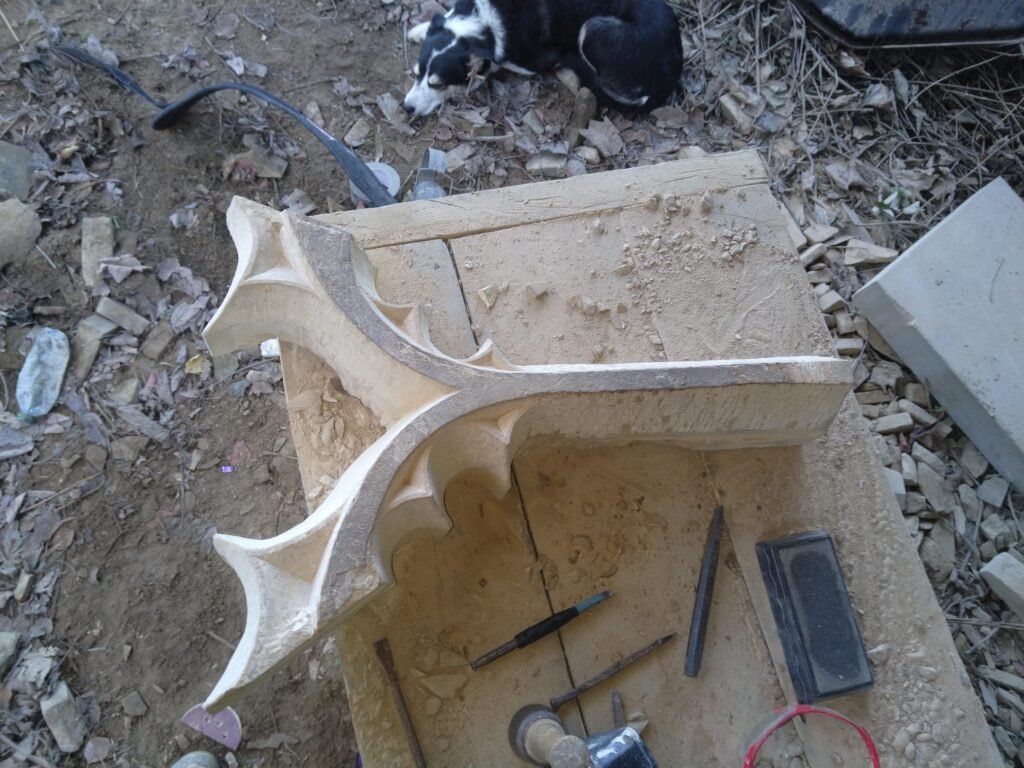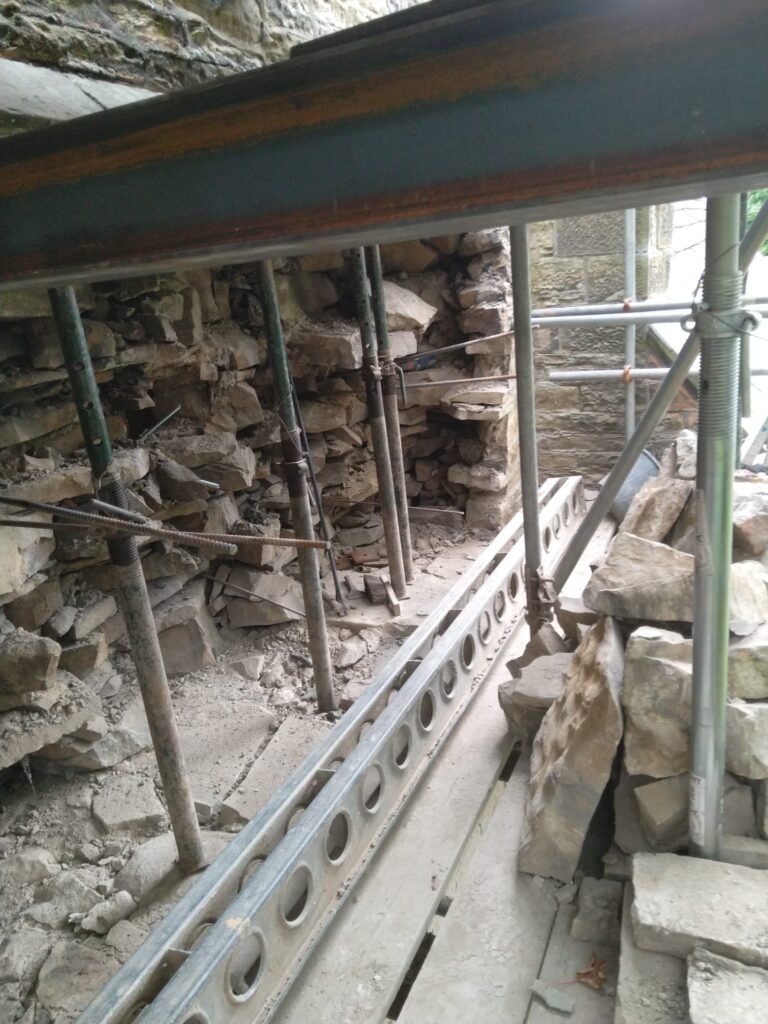James Northing’s account – of the restoration procedures of his work on a local church
It was and is my great honour and privilege to have been entrusted to take on this Mammoth task. I can’t honestly say that going into it that first morning, I felt wholly relaxed. It is certainly the most precarious repair that I have ever taken on; the kind of job that will hopefully make or indeed break a person. The ever present risk of the bulge on the west wall threatening collapse. That said I felt a confidence in my ability to do the task after taking on many similar jobs of a lesser calibre. Oftentimes (perhaps not enough) a baseline of faith is required to know that the unforeseen and hidden aspects of such a job will be revealed, followed with the correct course of action to deal with them. It is only possible to accomplish this description of task with a calm methodical approach, that considers each move carefully and seriously, to the degree of knowing that a mistake in such circumstances can mean the exchange of one’s own life or serious injury.
The first job
The first task on day one entailed making the bulge safe enough to insert the whaler and needles (the support system) as this itself would require a great deal of knocking and drilling. Vibrations at this stage could quite easily have been the final straw. It is for this reason that I added a temporary pattress plate to the peak of the bulge on the south wall, tying the outer leaf to the inner leaf. These first few hours were extremely nerve racking. I removed a whole stone from the inside as carefully as possible, I then began to mine into the 1.25m thick area of damaged wall (made thicker because of the 11” bulge protruding out). This was done by hand without the use of tools to minimise vibration.
As I worked, the already displaced infill continued to move and settle without permission! Thankfully it was already loose enough to remove by hand, otherwise this would have been an even more nerve racking experience. As I peered in to the chasm at 0.75m deep (about as far as I could reach) I could see that the stone infill, which would have been layered flat and uniformly was tipped to a 45 degree angle forcing its way outwards. I could also see as I peered in, beams of light shining in sporadically. In that moment it was as if beams of light were shining through from heaven itself as this meant one thing – I no longer needed to disturb the already precarious circumstances. There was an ideally situated and perfectly sized hole looking back at me. I quickly (and carefully) inserted a tie bar and got the temporary plates bolted on. It was only then that I could rest on a plateau and breathe a small sigh of relief. Following the insertion of the temporary plates I was much more at ease. I could focus on following the system compiled by the structural engineer Brian Jones. My journey was punctuated by encouraging conversations, updating Brian on my progress. I have thoroughly enjoyed working with Brian and had every confidence in his leadership.
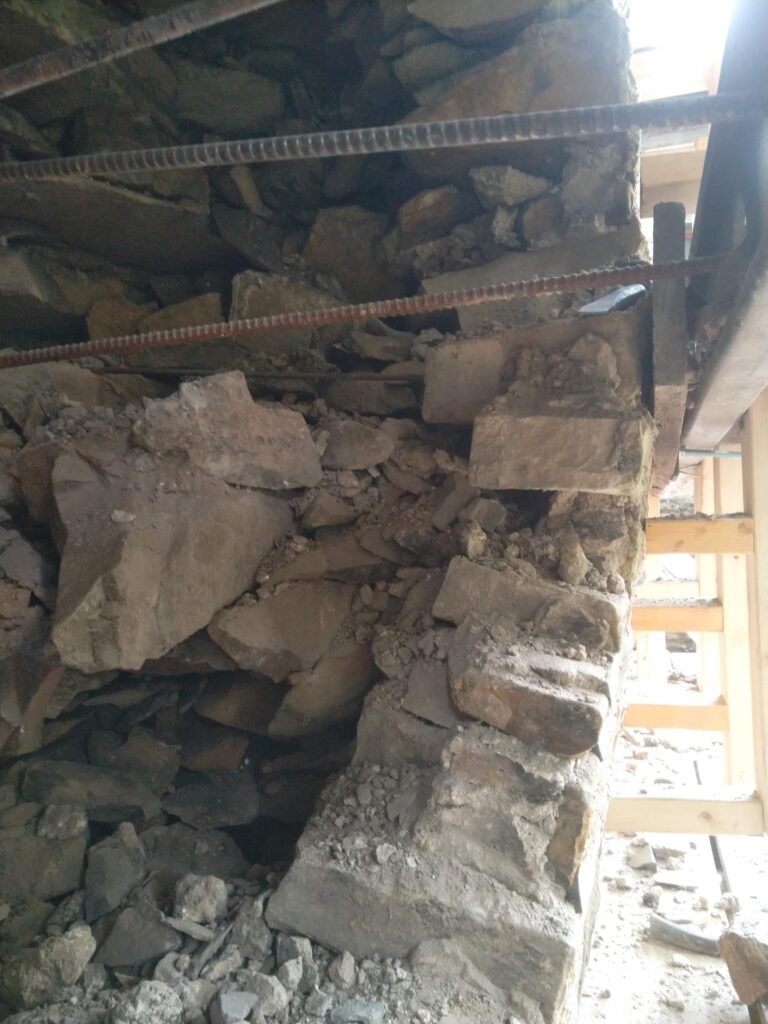
Figure 1: Cross section of bulge
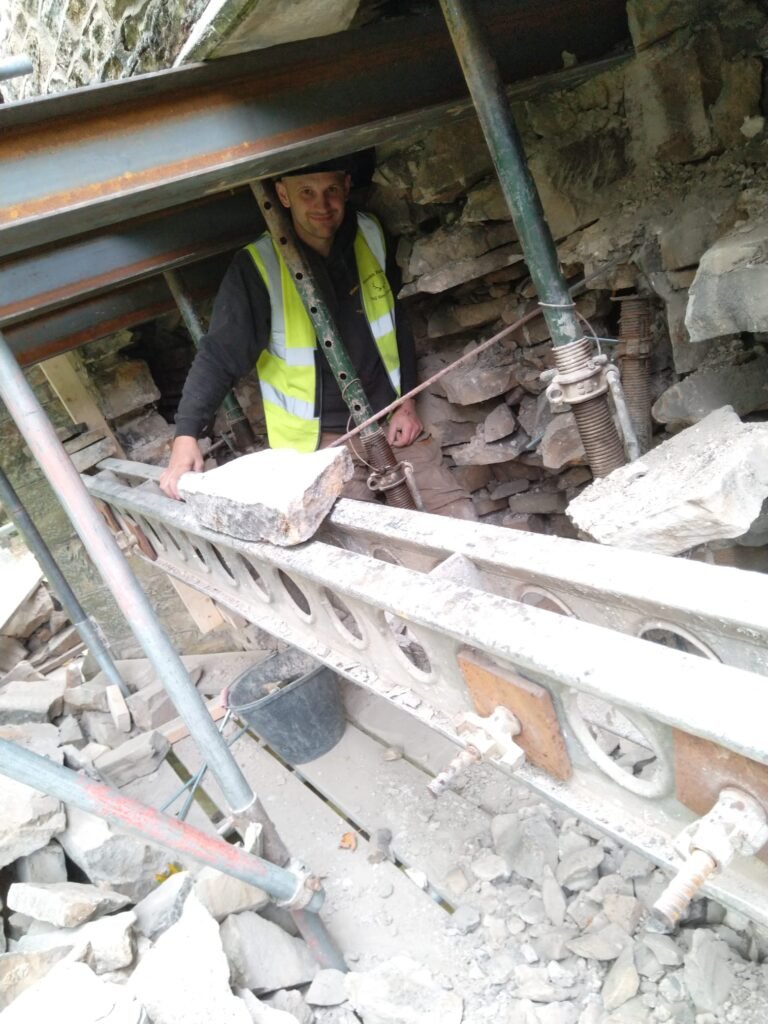
Figure 2: Room to spare
The removal
Everything went well with the removal of the offending bulge on the south side. A careful approach saw the job progress well and all the resulting problems were solved as a matter of course. The cavity that I opened up was big enough to walk through had not the steel supporting structure not been there. It was at this point that I sprained my ankle badly. My whole foot was swollen and purple but thankfully not broken so I took a few days off and strapped it up well with a good set of ankle boots. At the stage I was at ‘the show truly had to go on!’ It’s amazing how a dangerous task can be accomplished with precision and one can simply put a foot down wrong when feeling relaxed and almost bring everything to a halt! I’ve spent my whole life around power tools, workshops and hand tools and the worst cut I’ve had came from being in the kitchen, cutting a sweet potato. Steve Irwin springs to mind with his life spent wrestling crocs and meeting his end in a freak accident with a stingray. I do however accept that my sweet potato story is somewhat less dramatic and not really comparable. It is clear that several factors had contributed to the near demise of St John’s tower. Initially, the in-fill was placed looser in the band immediately following the lower string course, with a mix of large to medium dog sized pieces of stone, right down to gravel sized pieces placed loosely, with pockets of mixed dust and debris. This likely came from cleaning the original scaffolding off and dumping the waste into the cavity. It was this finer element of the infill that would become the issue. There has been historical water ingress from the roof for a long period of time, I would estimate this to be 50 – 80 years. This water has steadily eroded the finer infill causing it to settle downward, increasing pressure on the outer skin. This in turn left the string course, which varied from 0.5m to around 0.15m deep, without any support at the rear end. As a result this became the main support of the weight of the masses of infill above and in the areas where it was narrower, it was not adequately supporting the stonework above. This produced a canter-lever effect which began to pry the stonework below outward. Once this journey had begun there was only one way the wall could go – outward! The moisture within the bulge from the ingress above would also contribute to the outward force in the form of expansion and contraction at the extremes of temperature. Frost being the number 1 perpetrator in this circumstance as water expands when frozen. The roof and a few other badly affected areas still await repair. The insufficient lead-work in the parapet gutter is split in various places and the base doesn’t drain as it should, so most of the water that collects from the roof never makes it to the end of the drain pipe. It simply drains through the wall at roof level and at a mid point of the tower where the pipe passes through to the outside, the damage from this is evident throughout.
The window
Moving on to the west side the risk of mid work collapse was significantly reduced with just a 6” bulge over 2.4m. This is still considerable at the scale presented but significantly less than the 11” bulge over just 1.5m of height on the south side. This side was however much more complex. The challenge that the arch created meant that the support system required more components and was a more complicated system. The process was made more difficult by the reduction in space to work with the extra components and lower level access. Despite the difficulties that this task presented the work progressed smoothly, with the tracery being rocked back into its original position carefully, over the course of a day. Interestingly the arch, being a 10” x 48” x 60” solid slab of stone, had left its mountings either side of the window jambs and was sat solely on the two central mullions. Once this was safely back in position, much to the relief of the congregation, it was established that there were going have to be some repairs done at this point. This entailed the voussoirs and the hood moulding at first (which both cover the tracery) and then a repair to the tracery itself. This seemed to me like a travesty considering that the tracery itself was painstakingly carved from one huge slab of rock and I was going to effectively turn it into three, but it had to be done. The rotten part that was to be replaced had delaminated back a whole 3” and with the scaffolding erected it made sense to get it done.
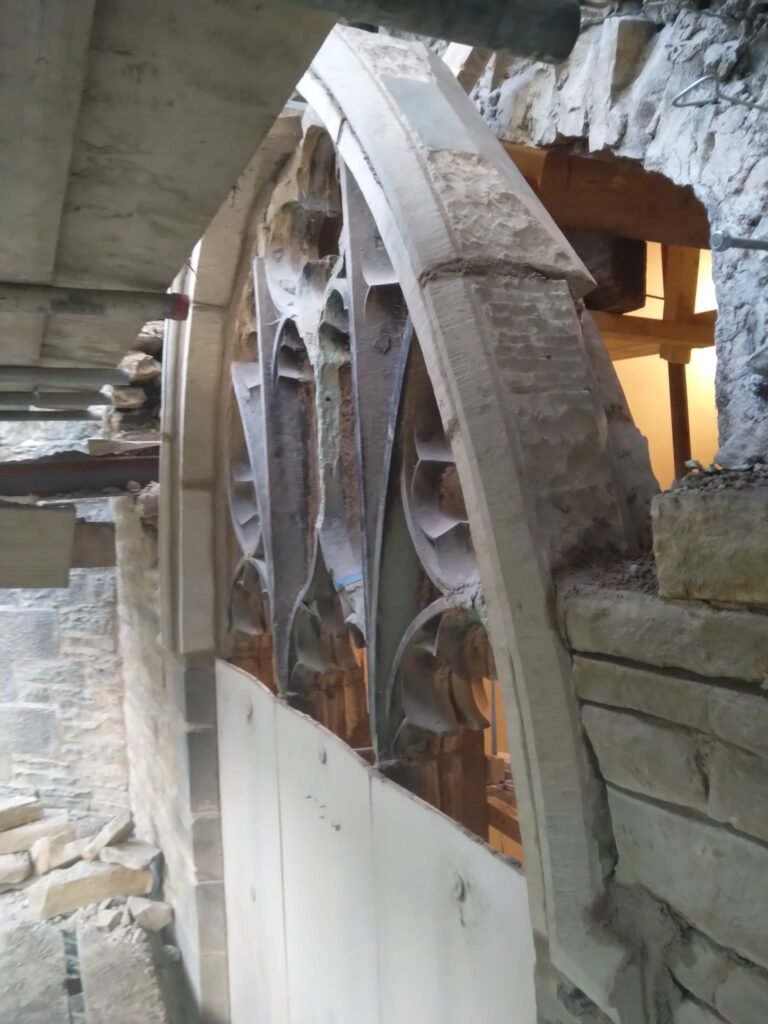
Figure 3: West window – new hood and voussoirs

Figure 4: Tracery repair pieces in place
The tracery repair
I was yet again bestowed with the honour, privilege and responsibility of working on this particular piece of tracery. The challenge required that I cut out a large piece of this magnificent piece of art and recreate it to fit as it once had. Most of the detail had worn away leaving just a basic shape to copy. I endeavoured to remove the brittle piece in one. Thankfully it was a success and was useable as a template. The rest of the detail was roughly traced from the opposite side which provided a near mirror image with the exemption of some degree of error owing to the handmade nature of the piece. The first piece of stone that I sourced was not up to the job so I set about driving around a few quarries, when I happened upon a digger about to process a pile of rock into crushed stone. There it was, the ideal piece. Straight from the ground, with an ideal graining, colour and density. I set about carving the replacement over the next week and this went very well without a single slip of the chisel. I made my makers mark during this job as I was very proud of the piece and my mum also said that I should.
Final stages
After the fitting of the tracery repair, hood moulding and voussoirs I was able to build back up, reloading the infill back onto the arches first and then building the front back up tied into the new infill. Getting the weight back onto the internal arch was a big relief as it was not straight forward, with the support system in the way, which made it difficult to load it evenly. When working with multiple tons of stone and mortar (approximately 9 tons of mortar over the whole project) over an unloaded arch you really have to be careful about how that weight is placed. The final part was to retie the adjoining buttress back, which had completely dislodged itself. The way that it was attached was wholly inadequate, with the use of a mitred edge and the odd tie. The core was again loose infill so I removed the loose material and rebuilt it back up solid, to properly support the top third of the tower corner. The inner edges were tied back in as a matter of course, while rebuilding the south and west sides. My labourer Jake came just at the right time. I had recently lost a member of staff who did return for a short while before leaving again. Without Jake and occasionally Josh my son at my side, the job would not have been possible.
The congregation of the church have also been wonderful to work with, supporting me and brightening my day with their joyful demeanours. This is of course not to mention the copious amount of tea, cake and biscuits we were supplied with, often home baked. One lady even giving me homeopathic treatment for my sprained ankle which seemed to work wonderfully and another sending me thank you cards from the church to express how grateful they were to see this ominous problem corrected. I really did feel part of the family.


